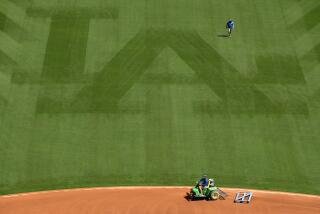Baseball Myths : Don’t Try to Hit a Rising Fastball With a Cork Bat, Physicist Says
NEW HAVEN, Conn. — Cork-filled bats are nothing for pitchers to fear, there is no such thing as a rising fastball and ground balls do not pick up speed bouncing over artificial turf, says a Yale physicist in a book that gives a scientist’s spin on America’s favorite pastime.
“The flight of balls, the liveliness of balls, the structure of bats and the character of the collision of balls and bats are a natural province of physics and physicists,” says Robert K. Adair in “The Physics of Baseball,” published this month by Harper & Row.
But “in all sports analyses, it is important for a scientist to avoid hubris and pay careful attention to the athletes,” writes Adair before stepping up to the plate with his calculations, worked out mostly on a personal computer using simple BASIC programs.
“If players think they hit better after illegally drilling a hole in their bat and filling it with cork, they must be taken seriously. The reason they give for their ‘improvement,’ however, may not be valid.”
Adair wrote the book at the urging of the late Bart Giamatti, who, as president of the National League, had asked his old Yale friend in 1987 to advise him on a few elements of baseball physics. Declining to be a paid consultant, Adair instead was bestowed with the title “Physicist to the National League.”
Among the findings he reported to Giamatti, who later became baseball commissioner, were that illegally modifying a baseball bat by drilling a hole in it and stuffing cork or rubber inside is, in effect, a crime without a victim.
Adair, who compared the weight and other characteristics of a Louisville Slugger before and after it had been filled with cork, concluded that the illegal modification provides the hitter no benefit that he cannot generally obtain through a legally constructed bat.
In fact, he found that while drilling a hole in the bat will make it lighter, the energy of the cork or rubber used as a filler cannot be effectively transferred to the ball. Therefore, the extra material will only slow the bat down a little, slightly reducing the distance the bat hits the ball.
For fans who take their statistics seriously, the 106-page book places a whole new realm of intriguing facts and figures at their disposal.
For instance, did you know that:
- There is no such thing as a rising fastball. Backspin on a ball will only make it fall less than it would otherwise as it crosses the plate. As far as the hitter is concerned, however, “it’s real and not an illusion” because it is seen as a higher pitch, Adair said.
- Ground balls cannot possibly speed up as they bounce across artificial turf infields. Long home runs are typically hit so the initial backspin is near 2,000 r.p.m., and ground balls have similar rates of overspin. Ground balls would not speed up even with an overspin as great as 4,000 r.p.m.
- From the perspective of the batter or pitcher, a wide-breaking curve ball thrown at 70 m.p.h. with a counterclockwise spin rate of 1,600 r.p.m. and aimed toward the inside corner has curved 14.4 inches to pass over the outside corner. But the largest deviation from a straight line from beginning to end is only 3.4 inches.
- Large hands and strong wrists do not a long-ball hitter make. The contribution of the hands and wrists to the energy of the bat is almost negligible.
- The collision of a ball on the bat lasts only about 1/1,000th of a second. But the force on a ball hit for a long home run reaches a value of nearly 8,000 pounds, compressing the ball to about half its original diameter.
- A humid day at the ballpark will not necessarily turn home-run balls into long outs. Humidity, in and of itself, has little effect on the ball’s flight, since water vapor is actually a little lighter than air. Balls stored under conditions of high humidity, however, will gain some weight through the absorption of water and their elasticity will be reduced.
Taking a look at the reputed advantages of aluminum bats, Adair concludes that they “will surely hit a ball appreciably farther than a wooden bat.”
On the subject of how far a baseball can be hit, Adair joins others who have questioned the accuracy of accounts that said Mickey Mantle hit a ball 565 feet in 1953 and Babe Ruth sent a baseball traveling 600 feet in 1919. According to his calculations, the maximum distance a ball can be hit is 450 feet under normal conditions and 550 feet when other conditions are taken into account.
More to Read
Go beyond the scoreboard
Get the latest on L.A.'s teams in the daily Sports Report newsletter.
You may occasionally receive promotional content from the Los Angeles Times.










